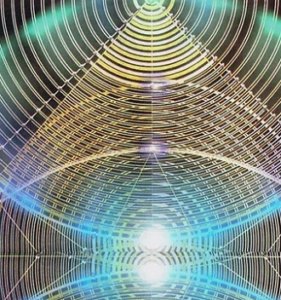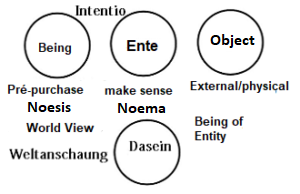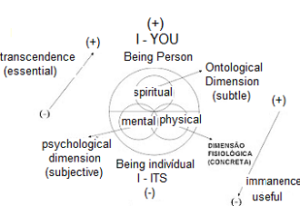
Posts Tagged ‘ONTOLOGIE’
The cosmos, the noosphere and perdition
In the chapter on “The loss of salvation, the unknown adventure” in Edgar Morin’s book Terra-Patria, he takes a deep look at our lack of cosmovision and the perdition of our microscopic concerns that don’t look at the larger world and reality around us.
unknown adventure” in Edgar Morin’s book Terra-Patria, he takes a deep look at our lack of cosmovision and the perdition of our microscopic concerns that don’t look at the larger world and reality around us.
He says at the beginning: “If there were space navigators, their route in the Virgo cluster would ignore the very marginal Milky Way and pass far from the small peripheral sun that orbits the tiny planet Earth. Like Robinson on his island, we set out to send signals towards the stars, so far in vain, and perhaps in vain forever. We are lost in the cosmos” (Morin, 2003, p. 163).
He adds: “This world that is ours is very fragile at the base, almost inconsistent: it was born of an accident, perhaps of a disintegration of the infinite, unless we consider that it arose from nothing” (idem, p. 163).
But in modern times, man has made his ego bigger, he wants to be a kind of “Homo Deus” using the metaphor of Yuval Harari, whose subtitle is “a brief history of tomorrow”, also pessimistic like Morin, but the author of Terra-Pátria hopes that man will find a new, more promising future.
Morin recognizes that “Life, consciousness, love, truth and beauty are ephemeral… We are on the move. We are on the move. We are not marching along a demarcated path, we are no longer guided by the law of progress, we have neither messiah nor salvation, we walk in the night and in the fog” (pgs. 164), he adds: “We are on an unknown adventure. The dissatisfaction that makes the journey begin again could never be satisfied by this. We must assume uncertainty and restlessness, we must assume dasein, the fact that we are there without knowing why” (p. 166), recalling this category dear to Heidegger, who elaborated on the ‘forgetfulness of being’.
How to start the journey again, we might ask, the author gives a “good news-bad news” (recalling the good news meaning of the word Gospel): “Here is the bad news: we are lost, irretrievably lost. If there is a gospel, that is, good news, it must start from the bad news: we are lost, but we have a roof, a house, a homeland: the small planet where life has created its garden, where humans have formed their home, where from now on humanity must recognize its common home (p. 166), and the response, even if agnostic, is no different from the evangelical one.
And then he recalls this call: “The call to fraternity is not confined to one race, one class, one elite, one nation. It comes from those who, wherever they are, hear it within themselves, and it is addressed to each and every one. Everywhere, in every class, in every nation, there are beings of ‘good will’ who convey this message” (Morin, 2003, p. 167).
And those of us who know this message, this hope, must not remain silent, indifferent or, what is much worse, adhere to hopelessness. We must remember that Gospel message: “To whom much has been given, much will be required” (Luke 12:39-48) under penalty of omission, distortion or abandonment of the fundamental message of earthly and heavenly salvation.
MORIN, Edgar and Kern, Anne-Brigitte. (2003) Terra-Patria “Earth-Patria”. Transl. Paulo Azevedo Neves da Silva. Brazil, Porto Alegre : Sulina.
Power, Anger and Time
At a time of threats and hatreds that call into question not only peoples, nations and cultures, but even the process of civilization, it is good to review what we think of power and anger.
question not only peoples, nations and cultures, but even the process of civilization, it is good to review what we think of power and anger.
Sloterdijk (2006) had developed the question of Anger in current times, in a context of political psychology, values such as pride, ambition and vanity contribute to what can be called, in times of networks, a verticalization of social life.
The author explains that the social theories of “social stratification based on domination, regression and privilege” have been replaced by ideas of individual disciplining (asceticism, virtuosity and performance), which are seen as the causes of vertical differentiation.
This seemed obvious both to Michel Foucault, the sponsor of this interpretative approach, who in the 1970s denounced the intimate relationship between discourse and discipline, and to the vision of the linguistic turn, in his famous language games, which linked the latter to behavioral figures and opened up to sociology (and some half-philosophies) the understanding of latent rituals, typical of communicative games.
Half-philosophies because Sloterdijk will contest this reading and also various strands of Anglo-American analytical philosophy, which see language games as egalitarian and relativist, which they are not.
The so-called vertical tension in Sloterdijk’s work has great relevance for ethics and pedagogy, as it establishes a hierarchy between values, without which ethics is sabotaged, and the educator, in pursuing something higher than the student, must have something more in his soul and body, and this is his discourse on “the exercise society”.
What these authors draw attention to is the contemporary destruction of interiority, a theme that Byung-Chul Han goes to the root of, but which Heidegger, Hannah Arendt and now Sloterdijk have already drawn attention to: being-in-the-world has destroyed what was considered for thousands of years to be the most important thing: radically distinguishing oneself from this world.
In Heidegger this discourse is already present, pointing out that man as someone who no longer has an interiority that can serve as a shelter, for the fugitive from the world that he would eventually choose to be, modern conditions, opposes the certainty of a more than true life on the horizon of reality or in a hypothetical “end of the world”, this was written long before today’s apocalyptic and pseudo-prophetic visions, without seeing the absence of asceticism.
Hans Jonas wrote: “act in such a way that the effects of your action do not endanger the permanence of authentic human life on earth!” (Jonas, 2006) and Edgar Morin calls for a (re)humanized humanity, finally reversing the process of violent power, hatred and war.
JONAS, Hans. (2006) Das Prinzip Verantwortung: Versuch einer Ethik für die technologische Zivilisation. Frankfurt Suhrkamp.
SLOTERDIJK, P. (2006) Zorn und Zeit. Frankfurt: Suhrkamp.
Noetics, Ontologie and War
For Plato, noesis is superior to dianoia, which is discursive and apparently logical, while the former is a high possible mental activity, inhabiting the sphere of Good and Harmony.
is discursive and apparently logical, while the former is a high possible mental activity, inhabiting the sphere of Good and Harmony.
It is a possibility of access to the “divine” world (Plato’s highest good which is in the eidos), it is transcendent, absolute, beyond ordinary human reasoning, philosophers pursue it without even touching on the question of the belief in a higher God where noesis “dwells”, it is not Being, but a mental attitude.
Dianoia, on the other hand, while it inhabits logical, mathematical and technical reasoning, is attached to what the mind can grasp of the earthly world, even though it admits to mistakes, truths that are not absolute and sometimes confusing, they inhabit the daily life of the human being, who is also disconnected from Being.
There is a foundational line that goes from phenomenology to the anthropotechnics of Peter Sloterdijk and Byung-Chul Han, essentially involving the question of Being, the link between noesis and noema, weakened by the bombardment of narratives that the digital universe has provided, but the forgetting of being, the absence of interiority have led to what Chul-Han calls “deauritization” and “pure facticity”:
“The disenchantment of the world expresses itself as de-auritization. Aura is the radiance that elevates the world beyond its pure facticity, the mysterious veil that envelops things” (Han, 2023, p. 80).
It’s not a question of denying facticity, but of not allowing its noesis, that is, the initial comprehension in the mind in all its aura, it makes a “narrative selection”, in the words of Byung-Chul (talking about photography): “It extends or shortens the temporal distance. It skips years or decades. Narrativity is opposed to chronological facticity” (Han, 2023, p. 81).
These are the lies of wars, of all wars because they hide their real motives, but particularly of current wars because they use narratives to change what is evident if read in chronological facticity, in a very current example, last week’s bombing of a hospital for the elderly in Ukraine (photo) and the bombing of UN bases in Lebanon, this correlates with cruelty and the absence of any narration to justify them.
Peace lies in the hearts and authorities that maintain the aura of hope, the spirit of solidarity.
Han, Byung-Chul. (2023) A crise da narração. Transl. Daniel Guilhermino. Brazil, Petrópolis: Vozes.
Heidegger and the affective tone
Intentionality is inherent to Being, it is a manifestation of interiority.
manifestation of interiority.
As a good orientalist, although based in Germany, Byung-Chul Han’s analysis does not start from the objectivist, materialist or substantialist perspective of the classic authors of Western philosophy, but from the holistic perspective of what he calls “affective tonality” in Heidegger.
To understand this different form of ascesis, contrary to the distance from the object that idealism proposes, the affective tonality “possesses an a priori anteriority that is not, however, attributable to the transcendental capacity of the subject, a pre-vision that sees before the object be outlined” (page 58).
Understanding objects as “beings”, “letting entities be, which is an attunement, penetrates and precedes all behavior that remains open and develops” and “the opening of entities in their totality does not coincide with the sum of currently known entities” (pg. 58), so any rationalist analysis is fragmentary and does not “see” the entities.
And furthermore, the “in the midst of beings in totality” is not verified by any reflection, so the thematization itself, “which always proposes an original scenario” is already an interpretation (pg. 59).
The affective tonality opens the space of there, according to Han, “which floods consciousness and which must be given in advance so that it can begin its thematizing work and discourse, and concludes with a quote from Heidegger: “Consciousness is only possible on the foundation of there as a derivative mode of it”.
Thus “the a priori event already presupposes an interpretation, and this temporal difference, which is placed before the interval of countable time, remains constitutive for the difference between being and being” (pg. 59), which is why ontologically the difference exists and not the idealistic separation as idealism supposes.
Thus, true ascesis is not a separation of the world (objective and subjective), but in the world through the difference between being and being, only a divided ascension (through death) can definitively separate being from being, thus we are in the relationship of an “affective tone ”.
Han, B.C. (2023) Coração de Heidegger: sobre o conceito de tonalidade afetiva em Martin Heidegger (Heidegger’s heart: on the concept of affective tonality in Martin Heidegger). Transl.Rafael Rodrigues Garcia, Milton Camargo Mota. Brazil, Petrópolis: Vozes.
Truth, noesis and The Bad
In the prolegomena to the first volume of Logical Investigations, Husserl, who had been strongly influenced by Franz Brentano, the father of social psychology, sees relativism and its basis in the turbid worldview as a problem, so the relativity of the existence of a world is neither objective nor subjective, but “the complete objective unity that corresponds to the ideal system of all truths of fact, and is inseparable from it” (HUSSERL, 2005, p. 136).
who had been strongly influenced by Franz Brentano, the father of social psychology, sees relativism and its basis in the turbid worldview as a problem, so the relativity of the existence of a world is neither objective nor subjective, but “the complete objective unity that corresponds to the ideal system of all truths of fact, and is inseparable from it” (HUSSERL, 2005, p. 136).
This is because each type of object has its own possible developments, so to speak, it has its own method prescribed a priori by laws of essence determined by the eidos of the objectivity in question (Husserl, 2006, 309), which means that it is the essence of the objectivity that predetermines the type of concordant development one has in experiencing it.
There can be the experience of evidence in this experience of the object, and this contributes to its status as an entity as a “true being” (Husserl, 2006, p. 309), what Husserl called “Lebenswelt”, a logic of life, in this case of the experience of the object.
In this way, an object that is “pure X” remains stable in the midst of the multiplicity of noematic characters that emerge in the course of an experience, the object targeted in thought by human consciousness, it precedes the first intuitive idea that is noesis (thinking X).
Husserl wrote that this noetic vision is a synthesis of identity, a central concept for establishing the “effective”, “true” object, the objectivity apprehended in evident donation, in a synthesis of concordant identity:
To every “truly existing” object corresponds as a matter of principle (in the a priori of unconditioned eidetic generality) the idea of a possible consciousness, in which the object itself is originally apprehensible and, moreover, in perfect adequacy. Conversely, if this possibility is guaranteed, the object is ipso truly existent” (HUSSERL, 2006, p. 316).
The syntheses involved in phenomenological thinking, for establishing the “being” or “non-being” of noematic correlated objects, are “intentionalities of a higher order”, which is what Husserl took from Franz Brentano’s neo-Thomist thinking, getting rid of the psychologism, the eidos that we have of good and evil, still scholastic from the father of social psychology.
In Husserl’s view, the intentionality of the evident giving of aspects of the object that are not yet present forms an intentional horizon, which in turn brings its predetermined potentialities, so the factual visions of war and peace, of the devil and evil are false.
They are ill-formed intentionalities (in the sense that they don’t have a noetic truth), the truth as “being”, as “the true” in the phatic and idealist readings, is for Husserl an “effectiveness” (Wirklichkeit) since it has coherence at its core.
Husserl, E. (2005) Investigações lógicas. Primeiro volume: Prolegômenos à lógica pura. Tradução de D. Ferrer. Lisbon, PT: Centro de Filosofia da Universidade de Lisboa.
Husserl, E. (2006) Ideias para uma fenomenologia pura e para uma filosofia fenomenológica. Tradução de M. Suzuki. Brazil, Aparecida, SP: Ideias & Letras.
Interiority, truth and wars
The abandonment of conceptions that lead humanity to elaborate inwardly, elevating thoughts and spiritualities, is pointed out in countless contemporary readings. We have posted here Heidegger, Hans-Georg Gadamer, Peter Sloterdijk, Edgan Morin and Byung-Chul Han, among others, of course.
humanity to elaborate inwardly, elevating thoughts and spiritualities, is pointed out in countless contemporary readings. We have posted here Heidegger, Hans-Georg Gadamer, Peter Sloterdijk, Edgan Morin and Byung-Chul Han, among others, of course.
But here we want to start with the question of method and return to the phenomenology of Husserl, one of the first to question “The Crisis of the European Sciences and Transcendental Phenomenology – An Introduction to Phenomenological Philosophy” (Brazilian edition by Forense Universitária, 2012), which points out this question and in the third part clarifies the transcendental question and the misunderstandings of contemporary science.
This is how he points out his questioning of the concepts of “outer experience” and “inner experience”: “The fundamental absurdity of wanting to seriously consider men and animals as dual realities, as a link between two realities of different kinds, comparable in terms of the sense of reality, and thus also wanting to research minds using the scientific-corporeal method, i.e. in a natural-causal way, existing spatio-temporally as bodies – resulted in the supposed obviousness of a method to be configured in a way analogous to that of the science of nature” (Husserl, 2012, pgs. 177-101). 177-178).
In this sense, he questions both Cartesian dualism and the foundation of a science that creates a “parallelism” where: “the physical-mathematical nature is the objectively true nature; this nature must be the one that announces itself in merely subjective appearances” (pg. 179), and his question is why “is not the nature of the world of life, this mere subjective element of external experience, but this is counterposed to external experience ?
Interiority in philosophy is a founding aspect as long as we look at the ontological question of Being, already present in Plato and Aristotle, and which in St. Augustine will play a central role in his worldview, where he seeks a profound sense of “beatitude” of the soul.
This interiority, reduced to the interior and immediate visions of the world, separates man from the world, from others, and he starts to project himself excessively onto objects, “things”, up to the apex of the digital world, called by Byung-Chul Han “non-things”, to talk about something that is currently on the rise, says the author: “artificial intelligence doesn’t think”.
This is how we move mechanically towards interests for external conflicts that lead us to increasingly contentious positions on values and non-values that justify violence.
The problem, as Husserl points out, is that all of this stems from a “method”, i.e. the particular way in which we look at the exterior and exercise our interiority, opposed in their origins by Brentano and Dilthey: “as in general in the 19th century, at the time of the passionate efforts to produce a rigorously scientific psychology, presentable alongside the science of nature” (pg. 180), but this psychologism is overcome by Husserl’s criticism of Brentano and later by Hans-Georg Gadamer.
What is interiority in sense of live, in new experience of conflits and wars ?
Husserl, E. (2012) A crise das ciências europeias e a fenomenologia transcedental: Uma introdução à filosofia Fenomenológica. Transl. Diogo Falcão Ferrer. Brazil, Rio de Janeiro: Forense Universitária.
(english edition) Husserl, E. (1970) Crisis of European Sciences and Transcendental Phenomenology, Translated by David Carr. Evanston, Illinois: Northwestern University Press.
Truth and Being
For Socrates, the truth was not with men, but between men, and with this he opposed Protagoras who said that “man is the measure of all things”, the relativism of the Sophists.
between men, and with this he opposed Protagoras who said that “man is the measure of all things”, the relativism of the Sophists.
Heidegger updates the concept of the truth of being (allétheia) and clarifies the misunderstanding that being as a present to the being of man, the misunderstanding that could occur, which would be to take the openness of being (geschlosenheit) as the determining element for understanding the truth of being (allétheia), the truth is not of man, but of being.
This dynamic relationship proper to the re-vealing of being (re-veiling, i.e. other veils) is not about the “function of the transcendental subject” who has the power of the keys to open up the true and the not true, which remains in the field of binary logic, but rather the power to unveil being.
The ambivalence of the play of tensions between Being and Appearance lies in the field of re-revelation, where truth is also ambivalent, but if thought of as Being, both can lead to a new re-revelation, says Heidegger: “Being, as appearance, is no less powerful than being, as re-revelation and discovery (unverbogenheit)” (Heidegger, 1984, p. 254).
In a way, for both Descartes and Kant, Heidegger sees them as looking at the world as something simply given, such as the physical and material world, since traditional ontology is structured in this way, being lives in a relationship between the thing and the intellect.
Thomas Aquinas already saw it this way, and what changes from Franz Brentano onwards is a Thomist sub-category of consciousness, which is consciousness of something, and then Husserl extends it to a return to the “thing in itself” (nature for Kant and Descartes) as intentionality and reduction (aidética, a name that comes from idea, but for the Greeks) which for him means creating a mental object.
Heidegger unveils this truth of being by realizing that there is an ek-sistent being of a being that flits from one object to another in everyday life, deviating from the mystery of Dasein.
In Heidegger’s view, there is no pure contemplation of Being, but rather a relationship between Being and Being, between appearance and essence, but, in our view, there is still a veiling of its finitude, of still remaining a being-of-the-sent, in other words, a thing even though it has an ontological relationship, transcendence remains in the object, what are we beyond the being?
We return to Heidegger’s partially-answered question: “What preserves being in this relationship with concealment?” I don’t want to force a theological hypothesis, but I’ll leave it up in the air: pure Being can enter into Being, without losing its essence, what will return from this finitude?
Heidegger, M. (1984) A tese de Kant sobre o ser. Brazil, São Paulo: Abril Cultural (Col. Os Pensadores).
The liquid visionaries
Analyzing Dilthey’s “romantic” vision of history, Hans-Georg Gadamer first emphasizes his rightness that “what we call the meaning of life is constituted, many times before any scientific objectification, within a natural vision of life about itself ” (GADAMER, 2006, p. 31).
Hans-Georg Gadamer first emphasizes his rightness that “what we call the meaning of life is constituted, many times before any scientific objectification, within a natural vision of life about itself ” (GADAMER, 2006, p. 31).
However, he will criticize Dilthey, that “every expression of life implies a knowledge that forms it from within”, and returning to the analysis from Hegel, he questions his vision of an objective spirit, if the “ethical environment in which he lives and the which he shares with others constitutes something “solid” that allows him to orient himself despite the somewhat vague contingencies of his subjective élans” (Gadamer, 2006, p. 32), the emphasis on the solid was made by the author.
The author remembers Dilthey’s “Investigating solid forms” (one of the themes of the Collection of Writings), which implies that both contemplation and reflection “always imply practical experience”, then contests Gadamer: “in Dilthey’s eyes, the objectivity of scientific knowledge, no less than the meditative reflection of philosophy, is an unfolding of the natural tendencies of life” (GADAMER, 2006, pp. 32).
In the same collection, recalls Gadamer, Dilthey said that “our task… will be to explain how the relative values of an era can acquire a somehow absolute dimension” and despite being a concern with the absolute, the path between relativism and totality is quite another, since Dilthey’s “being consciously a conditioned being” is not an explicit critique of idealism.
All this philosophy, says Gadamer, starts from a certain intellectualism, I would say, from a “liquid” visionary and points to an “intellectualist motivation of the objection to relativism, an intellectualism incompatible not only with the ultimate implication of his philosophy of life, but also with the starting point chosen by him, that is, the immanence of knowledge in life itself” (GADAMER, 2006, p. 36).
It clarifies Dilthey’s point of view “which demands that his philosophy extends to all domains in which “consciousness, through a reflective and doubtful attitude, finds itself freed from the dominance of authoritarian dogmas and aspires to true knowledge” ‘ (Gadamer, 2006, p. 34) quoting Dilthey himself in quotation marks, from his Collection of Writings.
The questions of the spirit in Hegelian philosophy always remained in the vague concept of the absolute, and never understood the question of contemplation, of a knowledge beyond, its transcendence is that which goes from the subject to the object without any divine or superior plan.
This was Thomas’ dilemma in carrying out the experience, although he lived with Jesus after his death, he was unable to maintain his conviction and needed to touch the master’s wounds.
GADAMER, H-G. The problem of historical consciousness. Trans. Paulo Cesar Duque Estrada. RJ: Rio de Janeiro: FGV, 2006.
Language, speaking and native culture
In the work of Heidegger: Hölderlin and the essence of poetry,  read in Heidegger (1992) speaks of the essence of poetry as a type of primordial language, an original speech that precedes and makes possible the common language, the communication, this refers to an unprecedented fusion of horizons in language and language, classically defines language as: “it is an organized set of elements (sounds and gestures) that enable the communication of a given nation or culture”, while language would encompass a broader set that includes the ability of human beings to develop and understand the language, as if it were possible to dissociate it from contexts, cultures and forms of communication linked to culture.
read in Heidegger (1992) speaks of the essence of poetry as a type of primordial language, an original speech that precedes and makes possible the common language, the communication, this refers to an unprecedented fusion of horizons in language and language, classically defines language as: “it is an organized set of elements (sounds and gestures) that enable the communication of a given nation or culture”, while language would encompass a broader set that includes the ability of human beings to develop and understand the language, as if it were possible to dissociate it from contexts, cultures and forms of communication linked to culture.
The common language in which a certain original culture is communicated, keeps its own forms of a linguistic code that is necessary for each original language and develops in a creative way in order to preserve it, this speech (or word) is said to be that one. who names the gods, and does so to respond to a cultural appeal.
If in the past narratives included myths, symbols and poetic hooks to connect the narrative, today it is no different, there is always in speech some belief and some fantasy, without which poetic language would be a mere exercise in rhetoric, and it is not, and this appeal to fantasy, imagination and the transcendent is part of the human and the divine.
Wanting all speech to be pragmatic and objective is to reduce it to the context of pure formal logic, scientific exercise also often needs some exercise in the beyond, in the imagination to find answers that are not just there as a logical equation.
It is not pure daydreaming, beliefs and imaginaries have always been part of human history, it is a just desire to go further, to seek higher flights and to imagine as possible something beyond the boring and heavy day to day, even though it may contain joys. and flavors, the threshold of openness to different original cultures cannot be linked only to objective and simple realism.
In the photo above, a syncretic church built in Kazan, started in 1992, therefore, in the post-Soviet period, capital of Tatarstan (Russian Republic, but with a totally different culture) where, even with the predominance of Islam followed by the Orthodox Church, it is at the same time a symbol of resistance to the Russian linguistic complex and capable of building a work of such great significance where different religions can express themselves, an eclectic work by the architect Ildar Khanov.
HEIDEGGER, M. (1992) Arte y poesía. Argentina, Buenos Aires: Fondo de Cultura Económica.
Truth and language
Is it possible to really speak? or to ask a more contemporary question, is it possible to deny the truth without falling into relativism? Only the logical truth that comes from Parmenides “being is and non-being is not”, was expressed until very recently as the only truth, but it is the foundation of positivism and dualistic logic, the idea of considering historicity and the hermeneutic circularity places subject and object within a relationship with language.
question, is it possible to deny the truth without falling into relativism? Only the logical truth that comes from Parmenides “being is and non-being is not”, was expressed until very recently as the only truth, but it is the foundation of positivism and dualistic logic, the idea of considering historicity and the hermeneutic circularity places subject and object within a relationship with language.
In this scope of the language of language, truth is re-signified, no longer conceived as unique, as a faithful description, and starting to be seen as a partial, creative but limited redescription of things, as a possible interpretation in a given context and cultural situation determination. , for this it is necessary to understand language as something prior to everyday language, what Heidegger called attention to in Hölderlin’s poetics as the essence of poetry as a type of primordial language, an originary speech that precedes and makes possible the common language, the Communication.
How then is it possible to speak of the truth? It is only possible to speak of the truth taking into account the historicity and hermeneutic circularity of subject and object, which are within the scope of language. Thus, the truth is re-signified, no longer conceived as unique, as a faithful description, starting to be seen as a partial, creative and limited redescription of things, as an interpretation among other possible ones. One possibility of speaking in truth is through language. But for that, it is necessary to resort to an understanding of language that is prior to the language of everyday life, of communication. In Hölderlin and the Essence of Poetry, Heidegger (1992, p. 125-148) speaks of the essence of poetry as a type of primordial language, an originary speech that precedes and makes possible the common language, the communication;
Since language is the mediation of our relationship with being, it is what establishes this relationship, more clearly what is said in Heidegger: “where does man assume the requirement to enter the essence of something? Man can only assume this demand from where he receives it. It receives it in the appeal of language … it is language that, first and ultimately, beckons us to the essence of something” (HEIDEGGER, 2002, P. 167-168).
Thus, the truth must be understood in the context of the linguistic turn (or reversal), the contemporary rediscovery of the importance of language and it cannot be separated from the original historicity, the one that refers to the culture of the peoples and religions of the past and the present.
HEIDEGGER, M. (2002). Ensaios e leituras (Essays and lectures). Brazil, Petrópolis: ed. Vozes.

